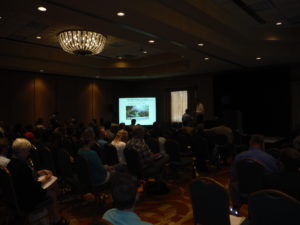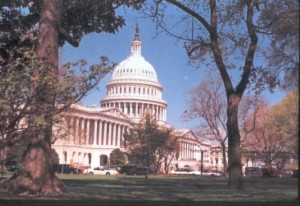As we know, North America’s trees are under severe threat from a growing number of non-native insects, pathogens, nematodes, etc. (For lengthy descriptions of the threat, substantiated by source citations, read the Fading Forests reports here; or check out a recent policy brief here; or short descriptions; or from my earlier blogs.)
I hope we all agree on broad goals in our efforts to counter this threat. I suggest those goals – broadly speaking, can be summarized as
- Preventing additional introductions to the greatest extent possible
- Detecting new introductions quickly, initiating rapid & effective eradication or containment actions
- Minimizing the risk of pest spreading from one state to others
- Implementing programs aimed at restoring pest-depleted tree species to forests
America decides what issues government agencies will address through politics – the squeaky wheel gets the grease. We care about the pest threat to trees … so it is up to us to persuade political players to support programs structured to achieve these goals.
There are several approaches to engaging politicians. These should be pursued simultaneously and in a coordinated way. And we must persevere — asking politely but persistently for specific actions. Success is not achieved by one-time actions, but by continuing effort.
What Can We Do?
We can ask our state’s Governor to
Immediate actions
- Communicate to the USDA Secretary the need to amend policies & regulations
- Communicate with governors of other states with severe tree pest issues to ask them to support approaches to USDA & Congress
- Put forest pest issue on the agenda of National Governors’ Association
- Communicate with our state’s Congressional delegation and ask them to pressure USDA Secretary to amend policies and regulations
- Communicate to the media both his/her concern about tree pest threats and proposed solutions.
Longer-term actions
- Ask our state’s Congressional delegation to support proposed amendments to the 2019 Farm bill (see below)
We can ask our state’s agricultural and forestry agency heads to
- Ask their national associations to support proposals to USDA Secretary & Congress. These associations include
- National Association of State Departments of Agriculture (NASDA)
- National Association of State Foresters (NASF) or its 3 regional groups – Northeastern Area Association of State Foresters, Southern Group of State Foresters, Council of Western State Foresters
- Communicate to the media both the agency’s concern about tree pest threats and proposed solutions.
 learning about forest pests (laurel wilt)
learning about forest pests (laurel wilt)
We can also act directly.
Ask mayors and officials of affected towns and counties to
- Push proposals at regional or National Conference of Mayors or National Association of Counties
- Instruct local forestry staff to seek support of local citizen tree care associations, regional and national associations of arborists, Arbor Day & “Tree City” organizations, Sustainable Urban Forest Coalition, etc.
- Reach out to local media with a message that includes descriptions of policy actions intended to protect trees — not just damage caused by the pests
- Ask stakeholder organizations of which we are a member or with whom we have contacts to speak up on the issue and support proposed solutions:
- USDA Forest Service
- State forestry divisions
- Professional/scientific associations
- Wood products industry
- State departments of agriculture
- State phytosanitary officials
- Forest landowners
- Environmental NGOs
- Urban tree advocacy & support organizations
- Encourage like-minded colleagues in other states to press the agenda with their state & federal political players, agencies, & media.
- Communicate to the media both your concern about tree pest threats and proposed solutions.
Our goal is to create a “parade” – the impression of a groundswell demanding action that politicians will want to join. (Usually, they like to appear to “lead” the parade!). Note what was said by a real “Washington insider”, Arthur Brooks, President of the American Enterprise Institute. “If you want to influence leaders, sometimes you have to start a parade.” Quoted in the Washington Post 2/10/17
What Should We Tell All These People, Specifically?
What should be the content of our message to these potential allies? I suggest a coordinated package. However, you might feel more comfortable selecting a few to address each time you communicate with a policymaker. Just choose those you think are most urgent, those you feel most passionate about, or those on which you have the most expertise. There is something for everyone below!
- Make specific proposals, not vague ideas (see below for suggestions)
- Always include information about how the pests arrive/spread (pathways such as imports of crates & pallets, or woody plants for ornamental horticulture) and what we can do to clean up those pathways (Don’t just describe the “freak of the week”)
- Always point out that the burden of pest-related losses and costs falls on ordinary people and their communities. (Aukema et al. 2011 provides backup for this at the national level; try to get information about your state or city.)
- We need to restore a sense of crisis to prompt action – but not leave people feeling helpless! We need also to bolster understanding that we have been and can again be successful in combatting tree pests.
Specific actions that will reduce risk that pests pose to our trees:
- Importers switch from packaging made from solid wood (e.g., boards and 4”x4”s) to packaging made from other materials, e.g., particle boards, plastic, metal …
This can be done by
— Persuading APHIS to initiate a rulemaking to require importers to make the shift. This can be done – although international trade agreements require preparation of a risk assessment that justifies the action because it addresses an identified risk (see my earlier blogs about wood packaging).
— Creating voluntary certification programs and persuade major importers to join them. One option is to incorporate non-wood packaging into the Department of Homeland Security Bureau of Customs and Border Protection’s (CBP) existing Customs-Trade Partnership Against terrorism (C-TPAT) program.
- Tighten enforcement by penalizing shipments in packaging that does not comply with the current regulations
— Persuade CBP and/or USDA to end current policy under which no financial penalty is imposed until a specific importer has been caught five times in a single year with non-compliant wood packaging. APHIS has plenty of authority to penalize violators.
The Plant Protection Act [U.S.C. §7734 (b) (1)] provides for fines ranging from $50,000 for an individual up to $1 million for multiple, willful violations. These penalties can be imposed by the Secretary of Agriculture after a hearing – but without going through a trial. So far, the Secretary has not used this power to deter violations.
- Restrict imports of woody plants that are more likely to transport pests that threaten our trees
— In 2011, APHIS adopted regulations giving it the power to temporarily prohibit importation of designated high-risk plants until the agency has carried out a risk assessment and implemented stronger phytosanitary measures to address those risks. Plants deserving such additional scrutiny can be declared “not authorized for importation pending pest risk assessment,” or “NAPPRA”. APHIS has proposed two lists of plant species under this authority. The second list was proposed nearly 4 years ago, but it has not been finalized so imports continue. APHIS should revive the NAPPRA process and utilize prompt listing of plants under this authority to minimize the risk that new pests will be introduced.
— APHIS should finalize amendments to the “Q-37” regulation (proposed nearly 4 years ago) that would establish APHIS’ authority to require foreign suppliers to implement integrated programs to minimize pest risk. Once this regulation is finalized, APHIS could begin negotiating agreements with individual countries to adopt systems intended to ensure pest-free status of those plant types, species, and origins currently considered to pose a medium to high risk.
— APHIS & USDA Foreign Agricultural Service should strengthen surveillance in foreign source countries for pests likely to attack North American trees, using such strategies as “sentinel trees” planted in botanical gardens.
- Strengthen early detection/rapid response programs by
— Providing adequate funds to federal & state detection and rapid response programs. The funds must be available for the length of the eradication program – which often requires a decade or more. The current “emergency” funds available as transfers from the Commodity Credit Corporation usually are cut off after only 1 – 2 years.
— Better coordinate APHIS, USFS, state, & tribal surveillance programs.
— Engage tree professionals & citizen scientists more effectively in surveillance programs.
- Enact Amendments to the 2019 Farm Bill to strengthen programs aimed at protecting North American trees from non-native insects and pathogens
— Stakeholders meeting under the auspices of several coalitions are considering what amendments to the Farm Bill could be advocated for the purpose of protecting our trees from non-native pests. Proposals under consideration would address such issues as
>> Strengthening APHIS’ pest-prevention mandate (which currently is conflated with a competing mandate to facilitate trade)
>> Providing increased and more reliable funding for detection, rapid response, and long-term restoration efforts
>> Providing incentives to importers to adopt pest-prevention programs beyond current legal requirements governing wood packaging materials
I will provide additional information about these proposals in coming weeks.
SOURCES
Aukema, J.E., B. Leung, K. Kovacs, C. Chivers, K. O. Britton, J. Englin, S.J. Frankel, R. G. Haight, T. P. Holmes, A. Liebhold, D.G. McCullough, B. Von Holle.. 2011. Economic Impacts of Non-Native Forest Insects in the Continental United States PLoS One September 2011 (Volume 6 Issue 9)
Posted by Faith Campbell
We welcome comments that supplement or correct factual information, suggest new approaches, or promote thoughtful consideration. We post comments that disagree with us — but not those we judge to be not civil or inflammatory.
